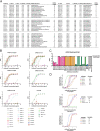Efficient discovery of SARS-CoV-2-neutralizing antibodies via B cell receptor sequencing and ligand blocking
- PMID: 35241839
- PMCID: PMC9378442
- DOI: 10.1038/s41587-022-01232-2
Efficient discovery of SARS-CoV-2-neutralizing antibodies via B cell receptor sequencing and ligand blocking
Abstract
Although several monoclonal antibodies (mAbs) targeting severe acute respiratory syndrome coronavirus 2 (SARS-CoV-2) have been approved for coronavirus disease 2019 (COVID-19) therapy, development was generally inefficient, with lead generation often requiring the production and testing of numerous antibody candidates. Here, we report that the integration of target-ligand blocking with a previously described B cell receptor-sequencing approach (linking B cell receptor to antigen specificity through sequencing (LIBRA-seq)) enables the rapid and efficient identification of multiple neutralizing mAbs that prevent the binding of SARS-CoV-2 spike (S) protein to angiotensin-converting enzyme 2 (ACE2). The combination of target-ligand blocking and high-throughput antibody sequencing promises to increase the throughput of programs aimed at discovering new neutralizing antibodies.
© 2022. The Author(s), under exclusive licence to Springer Nature America, Inc.
Conflict of interest statement
A.R.S. and I.S.G. are cofounders of AbSeek Bio. I.S.G., A.R.S. and K.J.K. are listed as inventors on antibodies described herein. I.S.G., A.R.S. and I.S. are listed as inventors on patent applications for the LIBRA-seq technology. J.E.C. has served as a consultant for Luna Biologics, is a member of the Scientific Advisory Board Meissa Vaccines and is Founder of IDBiologics. The Crowe laboratory has received funding support in sponsored research agreements from AstraZeneca, IDBiologics and Takeda. The Georgiev laboratory at VUMC has received unrelated funding from Takeda Pharmaceuticals. The remaining authors declare no competing interests.
Figures









Update of
-
Efficient discovery of potently neutralizing SARS-CoV-2 antibodies using LIBRA-seq with ligand blocking.bioRxiv [Preprint]. 2021 Jun 30:2021.06.02.446813. doi: 10.1101/2021.06.02.446813. bioRxiv. 2021. Update in: Nat Biotechnol. 2022 Aug;40(8):1270-1275. doi: 10.1038/s41587-022-01232-2. PMID: 34100018 Free PMC article. Updated. Preprint.
References
Publication types
MeSH terms
Substances
Grants and funding
- T32 GM008320/GM/NIGMS NIH HHS/United States
- R01 AI152693/AI/NIAID NIH HHS/United States
- R01 AI157155/AI/NIAID NIH HHS/United States
- P30 DK058404/DK/NIDDK NIH HHS/United States
- R01 AI131722/AI/NIAID NIH HHS/United States
- P30 EY008126/EY/NEI NIH HHS/United States
- P30 CA068485/CA/NCI NIH HHS/United States
- R01 AI127521/AI/NIAID NIH HHS/United States
- UL1 RR024975/RR/NCRR NIH HHS/United States
- UL1 TR002243/TR/NCATS NIH HHS/United States
- U19 AI142785/AI/NIAID NIH HHS/United States
- 75N93019C00074/AI/NIAID NIH HHS/United States
- T32 AI007392/AI/NIAID NIH HHS/United States
- G20 RR030956/RR/NCRR NIH HHS/United States
- U19 AI142790/AI/NIAID NIH HHS/United States
LinkOut - more resources
Full Text Sources
Medical
Miscellaneous

